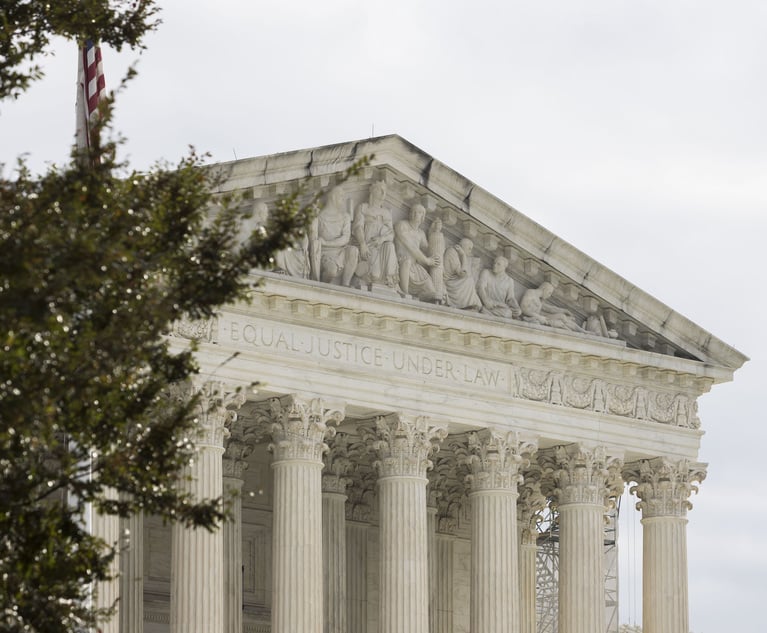Whispers and Secrets: Confidential Witnesses in Securities Litigation
In his Corporate Securities column, John C. Coffee Jr. writes: At present, the circuits are divided in their tolerance for unidentified "confidential witnesses." In this light, what can or should be done with respect to the use of confidential witnesses?
September 20, 2017 at 02:03 PM
30 minute read
A unique feature of securities litigation is the frequent reliance placed by plaintiff's counsel on confidential witnesses. Nowhere else does one regularly encounter detailed complaints that cite as many as 20 or more confidential witnesses (listed in order as C.W. 1, C.W. 2, C.W. 3, etc.), most describing damaging admissions allegedly made to these unnamed witnesses by individual defendants and/or senior executives at the principal corporate defendant. The origins of this anomaly are clear: Necessity was the mother of invention, as plaintiff's counsel had to find some means to satisfy the high pleading standards imposed by the Private Securities Litigation Reform Act (PSLRA), which requires (in a Rule 10b-5 case) that the plaintiff plead facts with particularity that give rise to a strong inference of fraud before the plaintiff can obtain discovery.1 Some defense counsel regard confidential witnesses as generating more fiction than fact, in order to help the plaintiffs surmount the PSLRA's high hurdle at the motion to dismiss stage and enter the subsequent stage where costly discovery induces defendants to settle. No case reveals anything this cynical, but several cases (discussed below) do show substantial distortion in the information transmission, as the witness's testimony is aggressively rephrased, as it passes from an initial investigator, to a junior associate, and finally to senior counsel.
At present, the circuits are divided in their tolerance for unidentified “confidential witnesses,” with the Seventh Circuit holding that the statements of confidential witnesses should be “substantially discounted”2 while the Second and Third Circuits permit the use of confidential witnesses “provided they are described with sufficient particularity to support the probability that a person in the position occupied by the source would possess the information.”3
In this light, what can or should be done with respect to the use of confidential witnesses? One real possibility is the development of “best practices” standards. The Federal Rules Committee is interested in this possibility, and, in support thereof, Duke University Law School sponsored a program this summer in New York City to discuss possible such standards with a specially invited group of federal judges and prominent practitioners. I served as moderator for the panel dealing with confidential witnesses but, because “Gresham House” rules applied, I cannot discuss the views of any specific participant. Still, it will surprise few to learn that plaintiff and defense counsel disagreed. The former thought that defense counsel “were inventing a solution for a problem that does not exist,” and defense counsel believed that the PSLRA was being outflanked by creative pleading that was only thinly grounded in fact. Equally significant, judges had a different problem: At the motion to dismiss stage, judges are not authorized to find facts, but must accept the well-pleaded allegations in the complaint. What, then, do they do when defendants produce affidavits from a confidential witnesses asserting they have been misquoted? Some cases have found ways to permit some fact-finding at this stage, but the legitimacy of these decisions was questioned by some of the participants.
This content has been archived. It is available through our partners, LexisNexis® and Bloomberg Law.
To view this content, please continue to their sites.
Not a Lexis Subscriber?
Subscribe Now
Not a Bloomberg Law Subscriber?
Subscribe Now
NOT FOR REPRINT
© 2025 ALM Global, LLC, All Rights Reserved. Request academic re-use from www.copyright.com. All other uses, submit a request to [email protected]. For more information visit Asset & Logo Licensing.
You Might Like
View All


Class Certification, Cash-Sweep Cases Among Securities Litigation Trends to Watch in 2025
6 minute read
Trending Stories
- 1The New Rules of AI: Part 2—Designing and Implementing Governance Programs
- 2Plaintiffs Attorneys Awarded $113K on $1 Judgment in Noise Ordinance Dispute
- 3As Litigation Finance Industry Matures, Links With Insurance Tighten
- 4The Gold Standard: Remembering Judge Jeffrey Alker Meyer
- 5NJ Supreme Court Clarifies Affidavit of Merit Requirement for Doctor With Dual Specialties
Who Got The Work
J. Brugh Lower of Gibbons has entered an appearance for industrial equipment supplier Devco Corporation in a pending trademark infringement lawsuit. The suit, accusing the defendant of selling knock-off Graco products, was filed Dec. 18 in New Jersey District Court by Rivkin Radler on behalf of Graco Inc. and Graco Minnesota. The case, assigned to U.S. District Judge Zahid N. Quraishi, is 3:24-cv-11294, Graco Inc. et al v. Devco Corporation.
Who Got The Work
Rebecca Maller-Stein and Kent A. Yalowitz of Arnold & Porter Kaye Scholer have entered their appearances for Hanaco Venture Capital and its executives, Lior Prosor and David Frankel, in a pending securities lawsuit. The action, filed on Dec. 24 in New York Southern District Court by Zell, Aron & Co. on behalf of Goldeneye Advisors, accuses the defendants of negligently and fraudulently managing the plaintiff's $1 million investment. The case, assigned to U.S. District Judge Vernon S. Broderick, is 1:24-cv-09918, Goldeneye Advisors, LLC v. Hanaco Venture Capital, Ltd. et al.
Who Got The Work
Attorneys from A&O Shearman has stepped in as defense counsel for Toronto-Dominion Bank and other defendants in a pending securities class action. The suit, filed Dec. 11 in New York Southern District Court by Bleichmar Fonti & Auld, accuses the defendants of concealing the bank's 'pervasive' deficiencies in regards to its compliance with the Bank Secrecy Act and the quality of its anti-money laundering controls. The case, assigned to U.S. District Judge Arun Subramanian, is 1:24-cv-09445, Gonzalez v. The Toronto-Dominion Bank et al.
Who Got The Work
Crown Castle International, a Pennsylvania company providing shared communications infrastructure, has turned to Luke D. Wolf of Gordon Rees Scully Mansukhani to fend off a pending breach-of-contract lawsuit. The court action, filed Nov. 25 in Michigan Eastern District Court by Hooper Hathaway PC on behalf of The Town Residences LLC, accuses Crown Castle of failing to transfer approximately $30,000 in utility payments from T-Mobile in breach of a roof-top lease and assignment agreement. The case, assigned to U.S. District Judge Susan K. Declercq, is 2:24-cv-13131, The Town Residences LLC v. T-Mobile US, Inc. et al.
Who Got The Work
Wilfred P. Coronato and Daniel M. Schwartz of McCarter & English have stepped in as defense counsel to Electrolux Home Products Inc. in a pending product liability lawsuit. The court action, filed Nov. 26 in New York Eastern District Court by Poulos Lopiccolo PC and Nagel Rice LLP on behalf of David Stern, alleges that the defendant's refrigerators’ drawers and shelving repeatedly break and fall apart within months after purchase. The case, assigned to U.S. District Judge Joan M. Azrack, is 2:24-cv-08204, Stern v. Electrolux Home Products, Inc.
Featured Firms
Law Offices of Gary Martin Hays & Associates, P.C.
(470) 294-1674
Law Offices of Mark E. Salomone
(857) 444-6468
Smith & Hassler
(713) 739-1250






